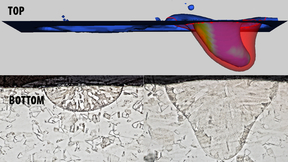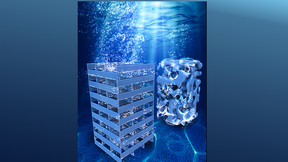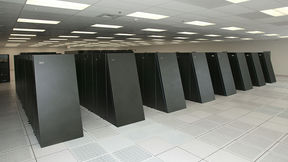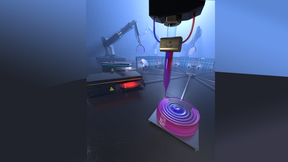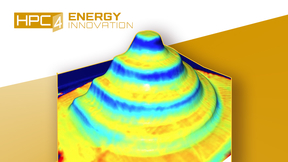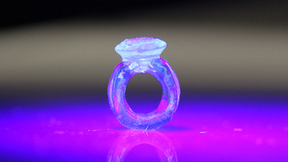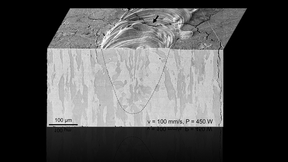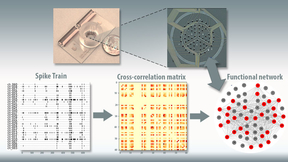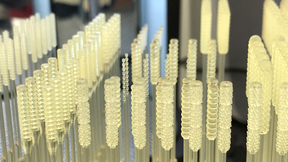Back
Engineering
Researchers measure electron emission to improve understanding of laser-based metal 3D printing
Lawrence Livermore National Laboratory (LLNL) researchers have taken a promising step in improving the reliability of laser-based metal 3D printing techniques by measuring the emission of electrons from the surface of stainless steel during laser processing. Researchers collected thermionic emission signals from 316L stainless steel under laser powder bed fusion (LPBF)…
Lab scientists among most cited researchers worldwide
Fifty-seven researchers from Lawrence Livermore National Laboratory (LLNL) were among the top 2 percent of the most cited researchers worldwide throughout their careers, according to research on metascience by Stanford University. Metascience is the "study of studies" using scientific methods. Stanford University professor John Loannidis worked alongside U.S.-based Kevin…
3D printed electrodes free the gas
Alkaline water electrolysis has been touted as a path to establish a hydrogen economy by converting intermittent renewable energies into clean hydrogen-based chemical energy. However, current technology has achieved only low current densities and voltage efficiencies. To make electrolysis more resourceful, a Lawrence Livermore National Laboratory (LLNL) team partnered with…
LLNL, IBM win SC20 ‘Test of Time’ for Blue Gene/L
A team of current and former Lawrence Livermore National Laboratory (LLNL) and IBM scientists won the annual “Test of Time” award at the 2020 Supercomputing Conference on Nov. 19 for a paper outlining LLNL’s Blue Gene/L supercomputer. Published by the Supercomputing Conference in 2002, the paper was the first peer-reviewed overview article to disclose details of Blue Gene…
3D-printed glass enhances optical design flexibility
Lawrence Livermore National Laboratory (LLNL) researchers have used multi-material 3D printing to create tailored gradient refractive index glass optics that could make for better military specialized eyewear and virtual reality goggles. The new technique could achieve a variety of conventional and unconventional optical functions in a flat glass component (with no surface…
Model for COVID-19 drug discovery a Gordon Bell finalist
A machine learning model developed by a team of Lawrence Livermore National Laboratory (LLNL) scientists to aid in COVID-19 drug discovery efforts is a finalist for the Gordon Bell Special Prize for High Performance Computing-Based COVID-19 Research. Using Sierra, the world’s third fastest supercomputer, LLNL scientists created a more accurate and efficient generative…
DOE announces five new energy projects at LLNL
The Department of Energy (DOE) today announced two rounds of awards for the High Performance Computing for Energy Innovation Program (HPC4EI), including five projects at Lawrence Livermore National Laboratory (LLNL). HPC4EI connects industry with the computational resources and expertise of the DOE national laboratories to solve challenges in manufacturing, accelerate…
New materials help expand volumetric 3D printing
Researchers at Lawrence Livermore National Laboratory (LLNL) have adapted a new class of materials for their groundbreaking volumetric 3D printing method that produces objects nearly instantly, greatly expanding the range of material properties achievable with the technique. The class of materials adapted for volumetric 3D printing are called thiol-ene resins, and they can…
Lab team develops first-ever living 3D-printed aneurysm to improve surgical procedures, personalize treatments
Brain aneurysms affect about one in every 50 Americans and can lead to serious medical emergencies, including stroke, brain damage and death if they burst. Existing treatment options are limited and often invasive, and surgical outcomes can vary widely from person to person. But medical practitioners may be able to improve existing treatment methods and develop new…
Research team pairs 3D bioprinting and computer modeling to examine cancer spread in blood vessels
Lawrence Livermore National Laboratory (LLNL) scientists have paired 3D-printed, living human brain vasculature with advanced computational flow simulations to better understand tumor cell attachment to blood vessels, the first step in secondary tumor formation during cancer metastasis. The unique approach, developed with outside collaborators, lays the foundation for…
Simulations, high-speed videos help researchers see crack formation in 3D-printed tungsten in real time
Boasting the highest melting and boiling points of all known elements, tungsten has become a popular choice for applications involving extreme temperatures, including lightbulb filaments, arc welding, radiation shielding and, more recently, as plasma-facing material in fusion reactors such as the ITER Tokamak. However, tungsten’s inherent brittleness, and the microcracking…
Machine learning model may perfect 3D nanoprinting
Two-photon lithography (TPL) — a widely used 3D nanoprinting technique that uses laser light to create 3D objects — has shown promise in research applications but has yet to achieve widespread industry acceptance due to limitations on large-scale part production and time-intensive setup. Capable of printing nanoscale features at a very high resolution, TPL uses a laser…
Modeling neuronal cultures on 'brain-on-a-chip' devices
For the past several years, Lawrence Livermore National Laboratory (LLNL) scientists and engineers have made significant progress in development of a three-dimensional “brain-on-a-chip” device capable of recording neural activity of human brain cell cultures grown outside the body. Now, LLNL researchers have a way to computationally model the activity and structures of…
Lab, BMI produce FDA-approved emergency ventilator
Following weeks of prototyping, Lawrence Livermore National Laboratory (LLNL) is partnering with private industry to mass-produce a simple mechanical ventilator developed for COVID-19 patients that has been authorized for emergency use by the U.S. Food and Drug Administration (FDA). LLNL and medical device startup company BioMedInnovations (BMI) have reached an agreement…
Lab provides assistance in national swab shortage
In this era of COVID-19, tracking the disease adequately enough to allow state and local officials to lift shelter-in-place orders and return to a semblance of normalcy in the absence of a vaccine will require widespread testing, according to medical experts. However, such extensive testing efforts have been hampered due to a shortage of nasopharyngeal (NP) swabs, the…
Lab devises plan to reduce defects in 3D metal printing
Combining high-fidelity computer simulations with ultra-high-speed X-ray imaging, researchers at Lawrence Livermore National Laboratory (LLNL) have discovered a strategy for reducing or even eliminating defects in parts built through a common, laser-based metal 3D-printing process. In work published by the journal Science, a research team at LLNL, along with collaborators…
LLNL develops ‘stopgap’ ventilator for COVID-19 use
While hospitals across the U.S. faced a possible shortage of mechanical ventilators due to COVID-19, a self-assembled “skunk works” team at Lawrence Livermore National Laboratory (LLNL) worked tirelessly to prototype a simple ventilator design for quick and easy assembly from available parts. Dubbed the “Novel Emergency Response Ventilator” (NERVe), the design is derived…
HPC4Energy Innovation Program issues special solicitation for American manufacturers
The High Performance Computing for Energy Innovation (HPC4EI) Program, managed by Lawrence Livermore National Laboratory (LLNL), has issued a special solicitation seeking industry partners to collaborate with the Department of Energy’s (DOE’s) national laboratories on projects to improve manufacturing processes. This special solicitation invites members of Manufacturing…
Open for business: NNSA, LLNL celebrate the dedication of new Advanced Manufacturing Laboratory
Officials from the National Nuclear Security Administration (NNSA) and Lawrence Livermore National Laboratory (LLNL) gathered with elected leaders and industry professionals recently to dedicate and tour the Advanced Manufacturing Laboratory, a new collaborative hub intended to spur public-private partnerships. The $10 million, 14,000-square-foot facility, located in the…
Lab researchers develop 3D ‘brain-on-a-chip’ device capable of long-term recording of neural activity
Lawrence Livermore National Laboratory (LLNL) engineers and biologists have developed a “brain-on-a-chip” device capable of recording the neural activity of living brain cell cultures in three dimensions, a significant advancement in the realistic modeling of the human brain outside of the body. In a paper published by the journal Lab on a Chip, LLNL researchers report on…


